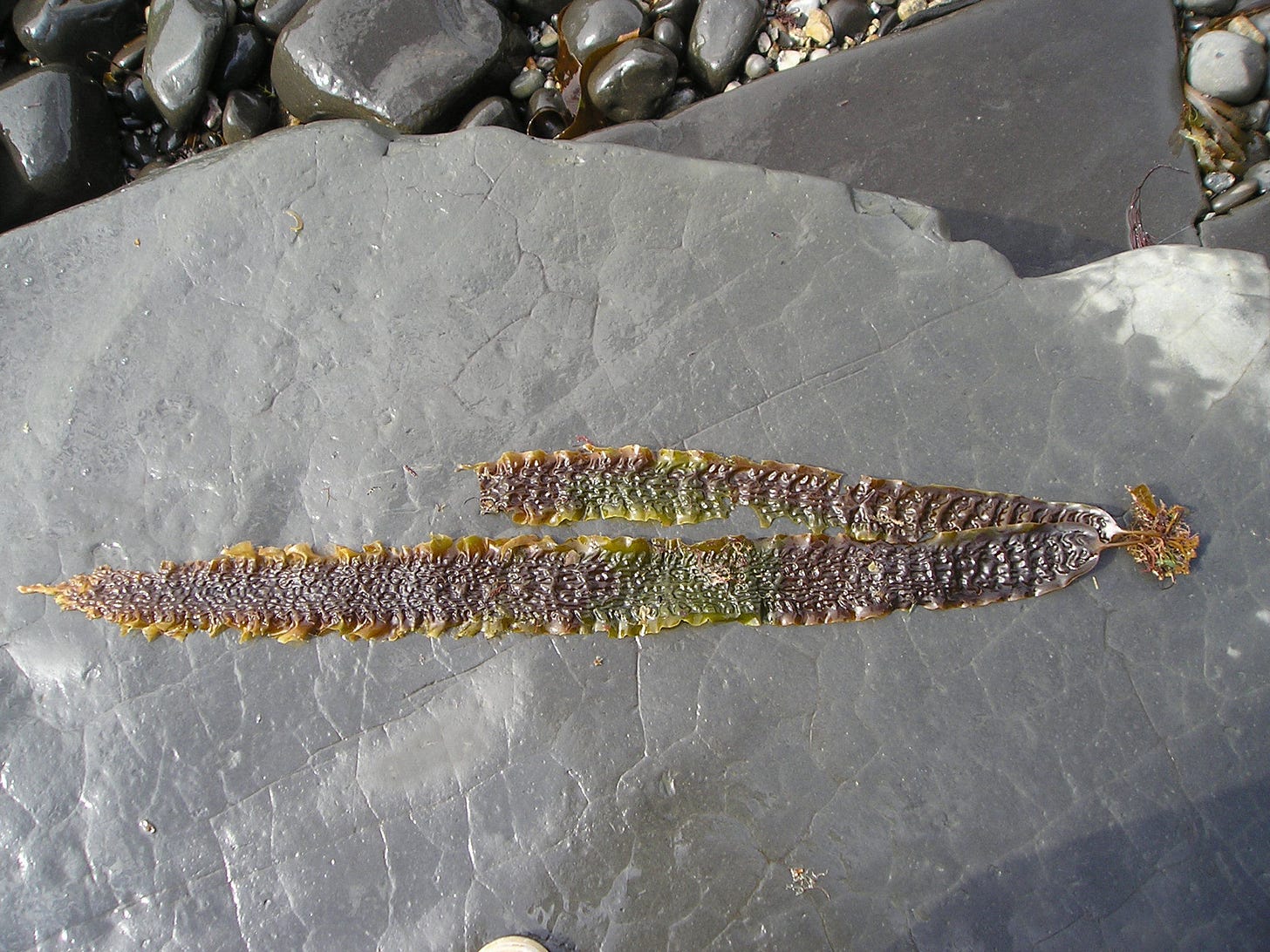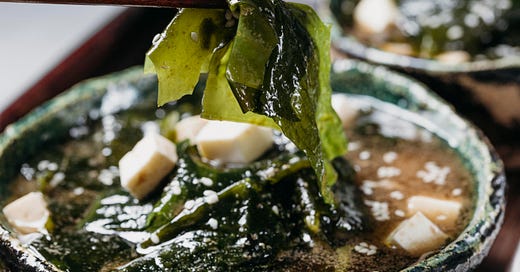Kelp: The seaweed that heals more than the ocean
Kelp isn’t just for miso soup. This seaweed can help store carbon. How? An oyster farmer and a scientist explain.
Dear Climate Culinarians,
You don’t often come across a positive story when you report about the sea. So I was in for a surprise. Oyster farmer Sue Wicks had a similar experience. “I was introduced to it by Stony Brook University when they were doing an experiment”, she says. That experiment involved oyster farmers in coastal New York and seaweed. Kelp, to be specific. Wicks googled it. In a heartbeat, she became what she calls “enthusiastically obsessed” with the environmental benefits and possibilities kelp promised. When we talk, a dose of joyful, sea salt-encrusted hope radiates through the phone. But I’m getting ahead of myself.
New here? Every month, Climate Culinarians picks one topic and publishes a series of newsletters about it, ending with a recipe (see the weekly structure here). June is all about a seaweed called kelp.
Sue Wicks is a former professional basketball player. She played at Rutgers University in the mid-1980s, then in professional basketball teams in Italy, Spain, Japan, and Israel. She joined the Women’s National Basketball Association in its inaugural 1997 season, came out in the early 2000s. At the time, Wicks was one of very few out lesbian athletes in professional sports.
Dribbling along a basketball court’s floor, dunking the ball in a net high above, you could argue Wick’s elements are earth and air. Fire, too, if you look at it metaphorically. Working as a coach later on, she kept within her elements. Until she didn’t. Now everything is about water: Holding a lease on a stretch of Moriches Bay off Long Island, Wicks has become a player in New York’s aquaculture.
“We started introducing kelp into New York waters in 2018, mainly on the idea of trying to incorporate it onto already existing oyster farms”, says Chris Gobler, Endowed Chair of Coastal Ecology and Conservation at Stony Brook University. At first, his science lab focused on the oyster farmers’ business. “We were mainly thinking about the oyster farmers and that they could have something else that they could harvest, particularly in the winter.”
What is kelp, and why would oyster farmers grow it?
When the water gets cold, oysters stop growing. Wicks tells me that she waits until June to replenish her oyster farm: She takes so-called seeds - baby oysters from a hatchery - out into the bay. Whereas she plants kelp in November, to be harvested around March, then completely taken off in June. Adding kelp to Violet Cove Oysters was a no-brainer for Wicks: She thinks it’s a brilliant crop. “Kelp requires no fertilizer, no land, and no chemicals.” Eventually, Wicks became the first commercial kelp farmer in New York.
From late fall to spring, saccharina latissima, the seaweed commonly known as sugar kelp, can grow up to 16 feet long. The yellowish brown-green algae then looks like a record-long lasagna sheet, the kind with the wavy sides.

In nature, these blades grow to underwater forests, providing hiding places and food for many sea creatures. Each of these seaweeds is attached to stones on the seabed, floating toward the light. Aquafarmers turn them upside down: They seed kelp onto string, and then wrap the string around ropes. These ropes go in the water as long horizontal lines, attached to buoys or docks.
What to do with seaweed … or: Who buys kelp?
Kelp has had a place in many cultures ranging from the Scottish inhabitants of the Orkney archipelago to the Eyak people in Alaska. The Japanese cultivate a close relative to the kelp Wicks is growing: Kombu (saccharina japonica) is a major ingredient in miso soup. Its umami taste is sought-after; kelp served as the raw material for the first commercially produced monosodium glutamate (MSG).

Kelp also stabilizes and emulsifies dairy products - and inks. It serves as a thickening or gelling agent in beauty products. Recently, sugar kelp has even been considered for making plastic alternatives in packaging.
“I think we are just at the tip of the iceberg of what we can use kelp for as we search for alternatives to some land-based farming”, says Wicks. She decided against selling her kelp harvest to the cosmetics industry. Instead, some of her kelp becomes food, but most of it is turned into a soil amendment. That, too, is part of scientific experiments. “We have put in a significant amount of time into trying to understand if kelp can be used as a fertilizer”, says Gobler.
The other end of the spectrum: harmful algae
The coastal oceanographer’s forays into the world of algae started with a problem: the brown tide. That is what Long Island locals called a 1980s algal bloom. The water turned brown. Clams and scallops died in droves. The brown tide even harmed the environment these bivalves live in, particularly by killing seagrass. “At the time, the word ‘harmful algal bloom’ didn’t even exist”, says Gobler, “and nobody really knew what was going on.”
Sue Wicks remembers the time before the first brown tide arrived in Long Island. “I grew up when you could go swim in the creek with no fear of getting sick from the water, and you could eat from its abundance without hesitation.” This abundance of seafood was her family’s source of income: Wick’s father harvested clams in the bay, like many generations before him. “My father basically lost his way of life, his career because of that”, she says about the brown tides. He moved to North Carolina, she went to Rutgers.
What is the biggest threat to the ocean?
Like Wicks, Christopher Gobler grew up where this brown tide happened. He spent the first part of his academic career trying to figure out the problem. His urge to protect coastal waters is palpable even when sober terms like “mass mortality” and “anthropogenic” slip into our conversation.
The professor is editor-in-chief of a scientific journal called Harmful Algae. Some of these algae are really scary. Recently, a school on the Carribean island Martinique had to close due to toxic gas released from stranded sargassum algae (read more about sargassum problems at The Guardian). Other toxic algae can accumulate in filter-feeding shellfish like oysters or clams. When you eat those, you’ll get shellfish poisoning. And brown tides? “Brown tide is totally innocuous for humans, but it is lethal to shellfish, can kill off seagrasses”, says Gobler. The scientist now also knows the main causes for the harmful algal bloom he experienced: humans.
The biggest threat isn’t a what, but a who. People like me and him and you.
We unwittingly provide perfect conditions for harmful algae to multiply like crazy.
First of all, our lifestyles push nitrogen and phosphorus into the ocean. These chemicals feed our lawns and veggie gardens. They feed algae, too. The nutrients are in our poop, in what farmers spread on their fields. But they won’t stay there. Nitrogen and phosphorus end up in the sea, thanks to rain, wind and leaky septic tanks.
Plus, many harmful algae thrive in a warming sea. That’s on us, too. We have been burning oil, coal, and gas, sending heat-trapping greenhouse gas into the atmosphere. It seems like a relief that these algal blooms rot, eventually. Then they, too, emit CO2, contributing to global warming.
Kelp is such a different beast.
The superhero qualities of kelp
Kelp raises the pH of seawater. So it can reverse ocean acidification, at least close to where it grows. That’s good news for, say, nearby oysters growing their shells.
Kelp also pulls carbon dioxide out of the water. When you harvest kelp, you take this carbon with you, so to speak. If you then use kelp in a garden as a soil supplement, experiments show that some of that carbon stays in the soil. So kelp can be a means for carbon storage.
Both of these effects could be part of climate solutions.
While alive in the water, kelp adds oxygen, too. And it looks like the seaweed can keep harmful algae from growing.
“Kelp is a brilliant crop that also does environmental work, remediating the quality and the health of the water”, says Sue Wicks. “There are a lot of positive ecosystem benefits of growing kelp”, says Chris Gobler.
When I talked to the kelp farmer and the scientist, my heart filled with radical optimism. And yet. I’m a journalist. A walking question mark. And all this sounded too good to be true. So I dug deeper, asked more questions and …
There is a catch.
What on earth the sea bed did I discover? I think you know what’s coming: You’ll read all about the catch with kelp in next week’s newsletter. Plus, there will be actions you can take to help.
Read, eat, repeat!
Petrina
Climate Culinarians is a project by me, Petrina Engelke. I write about climate and food, and I help other writers turn their ideas into a book people want to read. In other words: I’m a journalist and a book coach. Read more about this newsletter & me here.




We visited some islands in Washington (state) last week and the kelp beds were amazing. Not only as habitat for whales and seals and fish/crabs but also quite beautiful to watch them flowing with the surges and waves. Mesmerizing...